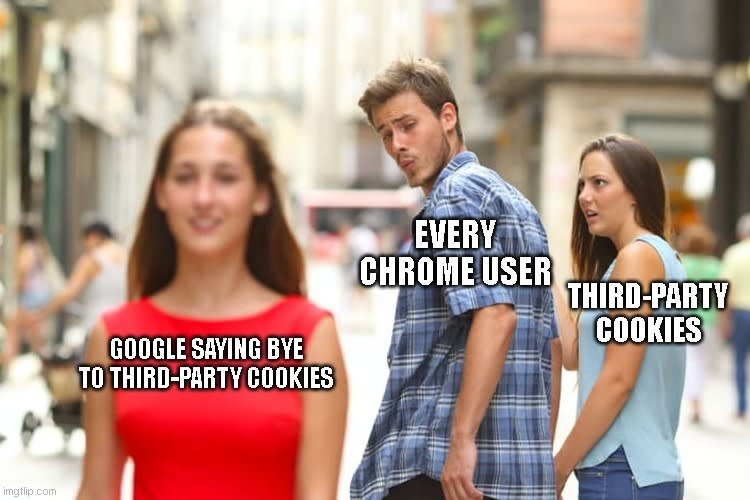The Cookie Monster's Dilemma: Google's Privacy Sandbox and the Future of Online Advertising
The Dawn of a New Internet Era
Today marks a pivotal moment in Google's ambitious plan to redefine internet privacy. The tech giant has initiated the phasing out of third-party cookies in Chrome, impacting about 30 million users initially. By the end of the year, this change will extend to all Chrome users, marking a significant shift in how online tracking and advertising operates.
Understanding Cookies and Their Future
What are Cookies?: Essentially, cookies are text files containing a unique string of letters and numbers, stored in your browser to recognize you in future sessions.
First-Party vs Third-Party Cookies: First-party cookies, managed by the site you're visiting, are safe and useful, aiding in functionalities like log-ins and cart memory. Third-party cookies, however, track your online behavior across different sites for advertising purposes – and these are what Google is phasing out.
Understanding Third-Party Cookies: The Backbone of Online Tracking
Third-party cookies have been fundamental to the internet's infrastructure, crucial for targeted ads and behavioral tracking. Sites use these cookies, created by other companies like Google, to monitor your online behavior. They've been so ubiquitous that avoiding them without specific tools like ad blockers has been nearly impossible.
Google's Privacy Pivot: From Public Outcry to Policy Change
In 2019, amidst growing privacy concerns and public outcry over tech giants' data practices, Google embarked on a project to eliminate third-party cookies in Chrome. Given that Chrome accounts for about 60% of internet usage, this change is set to reshape the online landscape significantly.
Enter Privacy Sandbox: Google's Solution to Privacy and Profit
Google's response to the cookie problem is the Privacy Sandbox, a set of sophisticated tools designed to balance user privacy with the needs of online advertising. The core idea is to have Chrome act as a data arbiter, sorting users into groups based on activities and interests without sharing individual browsing details.
The Mechanics of Topics: A Closer Look
Topics, a component of the Privacy Sandbox, categorizes your interests based on your browsing history. For instance, frequent visits to car websites might place you in a "car enthusiast" category. Advertisers can then target these interest groups without direct access to individual browsing habits, maintaining a level of privacy.
Challenges and Criticisms: Not Everyone's Convinced
While Google's plan is more privacy-conscious than the status quo, it still involves data harvesting for targeted advertising, which remains controversial. Other browsers like Firefox and Safari have blocked third-party cookies entirely without introducing similar tracking systems, leading to debates about the effectiveness and necessity of Google's approach.
Is the Web Ready for This Change?
The shift away from cookies might cause temporary disruption, but Google is implementing measures in Chrome to detect and address website issues stemming from this change. Interestingly, other browsers have successfully navigated this transition, suggesting the web's resilience and adaptability.
First-Party Cookies: Still on the Table
It's important to note that first-party cookies, which are more essential to website functionality and less invasive, will remain unaffected. These cookies facilitate basic website operations like log-ins and shopping carts.
Navigating Chrome's New Landscape
If you're among the initial batch of users experiencing this change, look out for a pop-up about Tracking Protection and an eye logo in the URL bar, signifying the shift. Chrome's settings also provide toggles and controls related to cookies, offering a degree of user control.
How to Tell if Chrome Killed Your Cookies
Curious if you're part of the 1% already experiencing a cookie-less Chrome? Here's how to find out:
Look for a Pop-Up: Chrome will notify you about Tracking Protection through a pop-up. This indicates you're among the initial group without third-party cookies.
Eye Logo in URL Bar: An eye logo will appear in your URL bar, a part of the Tracking Protection feature, signifying a cookie-less state.
Chrome’s Settings Check: Navigate to 'Privacy and security' in Chrome's settings. If the cookie-related toggles are enabled (and you didn’t do it yourself), you're likely in the cookie-less group.
Looking Forward: Balancing Privacy, Innovation, and Business Needs
As Google navigates regulatory challenges and industry criticism, the evolution of Chrome's privacy features will significantly impact digital advertising and user privacy. The question remains: Is Google genuinely innovating for privacy, or is it reshaping the online ad world in its image?
Conclusion
The transition away from third-party cookies marks a significant shift in the digital landscape. While Google's Privacy Sandbox and Topics offer a new approach to online tracking and advertising, the debate continues on the balance between privacy and business needs. As the internet adapts to these changes, the impact on users, advertisers, and the overall online experience will be closely watched.
About the Author:
Hello! I'm Sidharth Nayyar, a Full Stack Developer with a love for all things JavaScript, React.js, and Node.js. My journey through the world of computer science has been filled with exciting challenges and learning experiences. When I'm not deep in code, you can find me exploring the vibrant city of Vancouver, sharing tech tips, and connecting with fellow developers. My passion is making tech accessible and fun, and I'm here to share that adventure with you. Let's dive into the world of web development together!
You can check out my project on my portfolio




Top comments (0)